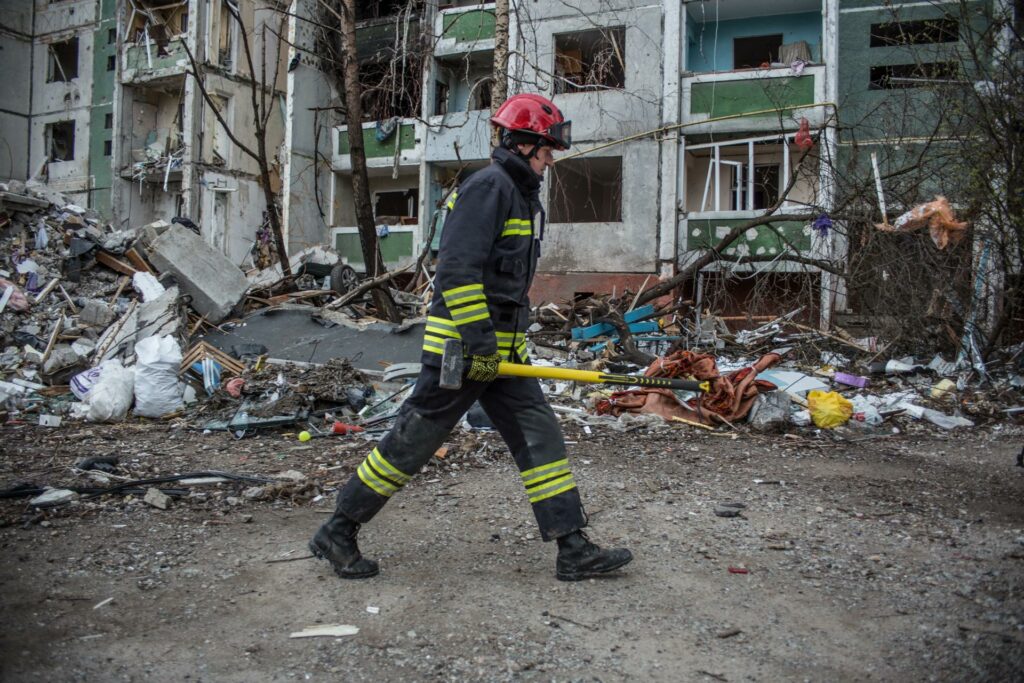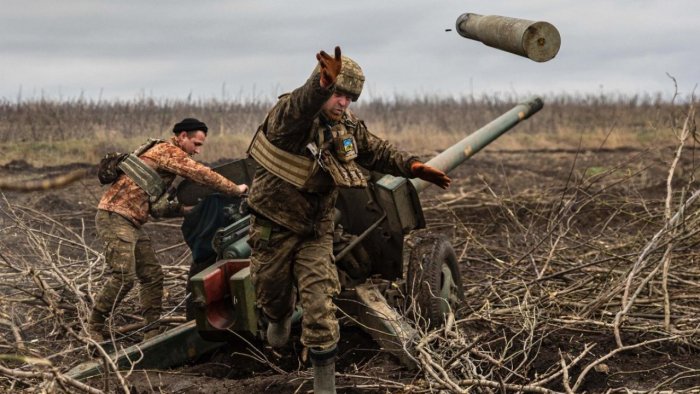Introduction

Since 2014, the ecological situation at the eastern border of Ukraine has shown a sign of significant deterioration as a result of Russian military aggression. The harmful effects on the environment have been amplified by the full-scale invasion, as Russia has utilized high-precision weapons to attack critical infrastructure such as hydroelectric power plants, water infrastructure, oil refineries, and chemical and pharmaceutical warehouses. This has resulted in the contamination of soil, air, surface and underground water. These have a direct impact on Ukrainian livelihoods and biodiversity leading to a major environmental catastrophe. Despite the severity of the situation, the effects on the environment have not received enough public attention, rendering it “an invisible front.” Last year, environmental NGOs and Ukraine’s Ministry of Environmental Protection and Natural Resources took steps to document the damage through initiatives such as EcoZagroza. According to EcoZagroza, there have been 2245 verified reports of military actions with a direct impact on the environment since the beginning of the full-scale invasion. As this report aims to show, the war has many far-reaching consequences on the environment, with Russia actively engaging in the weaponization of critical and civilian infrastructure and the environment. Accurately assessing the environmental damage is necessary for achieving justice and carries important implications for the post-war restoration and compensation plans.
Environmental Damage
Water pollution

Eastern Ukraine is a heavily industrialized region with an abundance of mines, factories, and refineries. The infrastructure has been subjected to frequent attacks by Russian missile strikes leading to the release of toxic substances into closed bodies of water and the ground. Since the beginning of Russian shelling, most mines in the region have been closed. The lack of supervision, and, thus, the lack of pumping mechanisms, risk the flooding of mines which leads to acid mine drainage or the outflow of toxic, contaminated water, usually with sulfur-bearing materials and metals. In recent river water samples from the Lviv area, the concentration of ammonia and nitrates was 165 and 50 times higher than the recommended limits, respectively. The shelling of the Voda Donbasu water treatment company led to frequent water interruptions and a general deterioration of water and sanitation infrastructure in the Donbas region for over 3 million people; since 2014, the water infrastructure has been damaged over 300 times leading to shortages and deterioration of sanitary condition introducing the possibility of the spread of water-borne diseases. Political and environmental experts have called this the Russian ‘weaponization of water.’ Russia is also emptying the Kakhovka Reservoir in Southern Ukraine which stores potable water for hundreds of thousands of people and provides irrigation for almost 500,000 million acres of farmland. It also supplies water for cooling of the Zaporizhzhia Nuclear Power Plant. Moreover, the destruction of toxic waste treatment facilities leads to contamination of nearby surface water and carries risks of long-term ground contamination, which can seep into groundwater. It is worth noting that 25% of Ukraine relies on groundwater for their water supply, amplifying the severity of the issue.
Marine ecosystem
The destruction of vital infrastructure, such as oil depots and sewage treatment plants, along the Azov-Black Sea coast can result in devastating consequences, including oil spills and the release of toxic waste to the sea. This would cause significant disruptions to marine life, including protected species as well as fish which are necessary for subsistence. The Russian use of underwater mines and radar equipment in the Black Sea has a disastrous impact on the marine ecosystem. Environmental organizations have reported a distressing number of deceased Black Sea dolphins and porpoises: by November 2022, the estimated number reached 50,000. These species are vulnerable not only to chemical pollution, but also acoustic pollution: the use of underwater sonar systems affects marine mammals that rely on echolocation for orientation and, ultimately, survival. This issue demands the immediate attention of countries surrounding the Black Sea, including Greece, Romania, Bulgaria, and Turkey.
Soil
More than 200,000 hectares of Ukrainian land are currently contaminated with debris, mines, and shells. The Russian military uses old Soviet equipment that runs on harmful propellants. The chemical compounds in the propellants cause immediate and long-lasting contamination of the soil. The most contaminated soil can be found at the locations where heavy equipment exploded. Not only do explosions leave behind large volumes of burnt metal that is compounded of elements damaging to soil, but they also result in spills of various liquids carried by military vehicles, including fuel and lubricant. Once a vehicle explodes, these toxic substances leak out and are absorbed by the soil. The high concentration of heavy metal in the soil constitutes a threat to human health and the arability of agricultural land. As a result, it will take decades for Ukraine to restore its food production.
Biodiversity

While Ukraine occupies only 6% of Europe’s territory, it is home to 35% of the continent’s biodiversity. Forest fires, loud explosions, and contamination of soil and water lead to the destruction of natural habitats. Many species have migrated, changing both the terrestrial and aquatic ecosystems. Since the beginning of the invasion, there have been more than 1500 reported cases of destruction of the ecosystem, including biosphere reserves and national parks. Indigenous species’ habitats like the Irpin wetlands may be irreversibly damaged due to war.
Air pollution and climate change
The use of explosive weapons, targeting of chemical warehouses and fossil fuel infrastructure, and wildfires are the leading causes of air pollution. Notable examples include the explosion of the 2022 Kharkiv firework warehouse as well as the 2017 Kalynivka ammunition depot explosion. Moreover, the destruction of military equipment, including tanks and armored combat vehicles (ACVs) are the leading causes of emissions of polluting substances into the atmosphere. This carries immediate risks to human health causing respiratory issues such as pneumonia and bronchitis. The war has also increased the release of greenhouse gas (GHG) emissions which directly impacts global warming. In the first seven months of the invasion, at least 100 million tons of CO2 were released in the atmosphere.
Implications for Post-War Restoration
While the Ukrainian government, activists, and civil society are gathering environmental data, recording instances of war damage to nature, the question of how do we keep Russia accountable for its ecocide in Ukraine remains.
Ukraine estimated the measurable, immediate environmental damage from Russia’s war at $46 billion. In addition to direct damages, Russia’s war against Ukraine has diverted Ukraine’s resources away from environmental policies and climate action, which has long-term implications for sustainable development. After almost a decade of work, the International Law Commission, which is the legal body within the UN, adopted the final version of 27 Draft Principles for environmental protection in relation to armed conflict in May 2022. This is a positive and innovative development as the proposed principles blend the laws of armed conflict and best practices, encouraging States and international organizations to ensure that “damage does not remain unrepaired or uncompensated,” among other provisions. The principles will be referred to the UN General Assembly for further consideration.

Ukraine is exploring various avenues that will allow it to hold Russia accountable for the environmental damage. The crime of ecocide has been included in the Ukrainian criminal code in 2001. At the international level, the International Criminal Court does not currently recognize ecocide as a crime despite growing pressure to do so; however, international humanitarian law prohibits employing methods of warfare that intend to damage the natural environment. Ukraine has been clear that it will seek reparations from Russia, which could potentially be extracted through seized Russian assets in specific countries. President Zelenskyy keeps ecocide high on the agenda in his 10-point peace plan, which is also one of the country’s preconditions for entering peace negotiations with Russia.
There are few precedents of compensation mechanisms at the international level. The Compensation Commission was established by the UN Security Council in 1991 to require Iraq to pay reparations for damage during its invasion of Kuwait, including environmental damage. With Russia having veto power in the Security Council, this might not be an option. However, the resolution “Furtherance of remedy and reparation for aggression against Ukraine” adopted by the General Assembly in November 2022 recommended developing a register of the damages to the environment at the international level, which could be a step towards accountability.
Conclusion

Environmental damage affects the health, food supply, and livelihoods of Ukrainians. The ecological consequences have implications beyond local borders, affecting transboundary air and waters like the Black Sea. Nongovernmental and governmental organizations alike are monitoring environmental damage to estimate the required funds and time to restore the civilian and critical infrastructure, and the ecosystem. Full restoration of the environment will take decades and the long-term effects will likely remain overlooked due to difficulties in measurement and lack of legal mechanisms. Nevertheless, seeking accountability for the immediate environmental damage will be crucial in achieving justice and will create an important precedent for the future.
By Zuzanna Iwanejko, Maryna Maiboroda, and Daryna Lesniak
Sources:
Cottrel et al. (2022). “Explosive Weapons Use and the Environmental Consequences: Mapping Environmental Incidents in Ukraine” The Journal of Conventional Weapons Destruction.
Kroeger, Alix (2023). “How the War in Ukraine is Killing Marine Mammals” BBC https://www.bbc.com/future/article/20221222-how-the-war-in-ukraine-is-killing-marine-mammals
Rawtani et al. (2022). “Environmental damages due to war in Ukraine: A perspective.” Science of Total Environment
“Ukraine Conflict Environmental Briefing: Fossil Fuel Infrastructure” (2023). Conflict and Environment Observatory
“Ukraine Conflict Environmental Briefing: The Coastal and Marine Life” (2023). Conflict and Environment Observatory
“Ukraine Conflict Environmental Briefing: Water” (2023). Conflict and Environment Observatory
